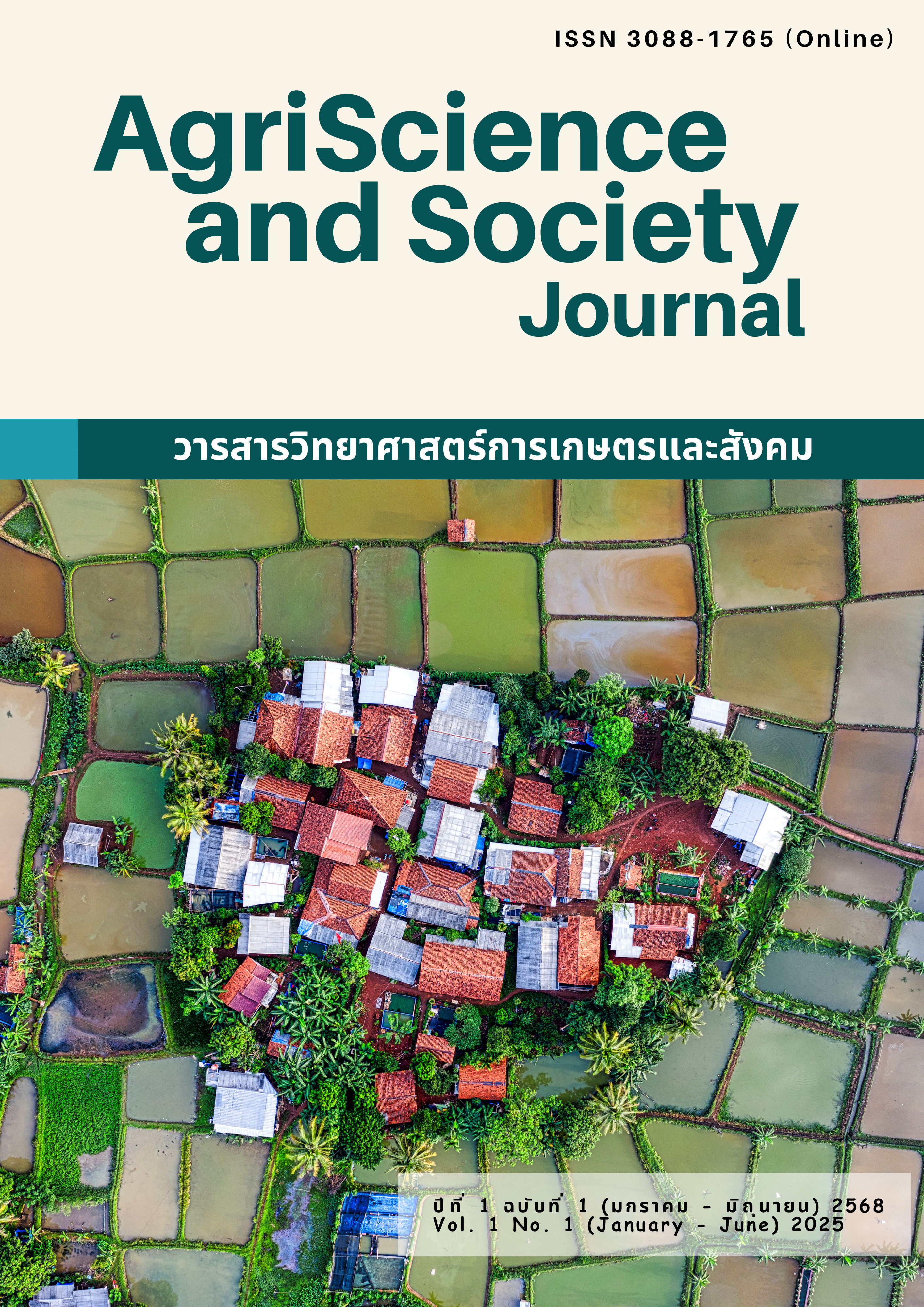Genetic Diversity Analysis and Identification of Plai-Dum (Zingiber ottensii Valeton) in Thailand with Molecular Markers
Keywords:
Plai-Dum, SSR, genetic diversity, identificationAbstract
Plai-Dum (Zingiber ottensii Valeton) is a local medicinal herb primarily found in southern Thailand belonging to the Zingiberaceae family. The plant is characterized by zerumbone as a major component in its essential oils, which exhibits antimicrobial, anticancer, and anti-inflammatory properties. This study investigated the genetic diversity and classification of Plai-Dum using molecular markers. A total of 34 accessions of Z. ottensii from Thailand and 19 accessions of other Zingiber species were collected and analyzed. Fifty-eight simple sequence repeat (SSR) primer pairs were screened, and 33 pairs successfully amplified DNA through PCR. Among these, 14 pairs of SSR primers showed polymorphism in Z. ottensii and related species The analysis detected a total of 150 alleles with an average of 10.71 alleles per primer. Cluster analysis based on genetic relationships using UPGMA classified all accessions into three distinct clusters. Cluster 1 consisted exclusively of Z. ottensii accessions. Cluster 2 included Z. zerumbet, Z. flavomaculosum, Z. montanum, and Z. parishii, while cluster 3 comprised Z. officinale accessions. The genetic similarity coefficient ranged from 0.57 to 1.00, with an average of 0.83. Notably, all Z. ottensii accessions showed the highest genetic similarity coefficient (1.00), indicating a common origin and identical clones with the same genetic information within Thailand. This genetic uniformity likely results from the common practice of asexual propagation through rhizomes, which produces genetically identical offspring. The study identified ZOSSR25 as an effective marker for distinguishing Z. ottensii from other Zingiber species, demonstrating the utility of SSR markers as rapid and reliable tools for identifying seedlings in plantation establishment.
References
Surin Piyachoknagul. (2009). DNA markers: From basic principles to applications. Bangkok: Kasetsart University Press.
Awasthi, P., Singh, A., Sheikh, G., Mahajan, V., Gupta, A.P., Gupta, S., Bedi, Y.S., and Gandhi, S.G. (2017). Mining and characterization of EST-SSR markers for Zingiber officinale Roscoe with transferability to other species of Zingiberaceae. Physiology and Molecular Biology of Plants, 23(4), 925–931. https://doi.org/10.1007/s12298-017-0472-5
Das, A., Gaur, M., Barik, D.P., and Subudhi, E. (2017). Genetic diversity analysis of 60 ginger germplasm core accessions using ISSR and SSR markers. Plant Biosystems, 151(5), 822–832. https://doi.org/10.1080/11263504.2016.1211197
Faridah, Z., Abdelmageed, A.H.A., Julia, A.A., and Hafizah, R. (2011). Efficient in vitro regeneration of Zingiber zerumbet Smith (a valuable medicinal plant) plantlets from rhizome bud explants. African Journal of Biotechnology 10, 9303–9308. https://doi.org/10.5897/AJB11.1182
Gawel, N.J., and Jarret, R.L. (1991). A modified CTAB DNA extraction procedure for Musa and Ipomoea. Plant Molecular Biology Reporter 9, 262–266. https://doi.org/10.1007/BF02672076
Lee, S.Y., Fai, W.K., Zakaria, M., Ibrahim, H., Othman, R.Y., Gwag, J.G., Rao, R., and Park, Y.J. (2007). Characterization of polymorphic microsatellite markers, isolated from ginger (Zingiber officinale Rosc.). Molecular Ecology Notes 7, 1009–1011. https://doi.org/10.1111/j.1471-8286.2007.01757.x
Ly, S., Truong, V., and Huong, Le. (2016). Zingiber ottensii Valeton (Zingiberaceae) – a newly recorded species for Vietnam. Bioscience Discovery 7, 93–96.
Mohamed S.A., Hussein, S.T., Usama, I.A., Hattem, M.E., and El-Sayed I.G. (2011). In vitro propagation of ginger (Zingiber officinale Rosco). Journal of Genetic Engineering and Biotechnology, 9, 165–172. https://doi.org/10.1016/j.jgeb.2011.11.002
Mondini, L., Noorani, A., and Pagnotta, M.A. (2009). Assessing plant genetic diversity by molecular tools. Diversity, 1, 19–35. https://doi.org/10.3390/d1010019
Panyajai, P., Chueahongthong, F., Viriyaadhammaa, N., Nirachonkul, W., Tima, S., Chiampanichayakul, S., Anuchapreeda, S., and Okonogi, S. (2022). Anticancer activity of Zingiber ottensii essential oil and its nanoformulations. PLoS One, 17, e0262335. https://doi.org/10.1371/journal.pone.0262335
Rohlf, F.J. (2002). NTSYSpc Numerical Taxonomy and Multivariate Analysis System. New York: Applied Biostatistics.
SaiSug, W., and Ukoskit, K. (2013). Comparative analysis of EST-derived markers for allelic variation in Jatropha curcas L. and cross transferability among economically important species of Euphorbiaceae. Genes & Genomics 35, 1–12. https://doi.org/10.1007/s13258-013-0064-x
Sharifi-Rad, M., Varoni, E.M., Salehi, B., Sharifi-Rad, J., Matthews, K.R., Ayatollahi, S.A., Kobarfard, F., Ibrahim, S.A., Mnayer, D., Zakaria, Z.A., Sharifi-Rad, M., Yousaf, Z., Iriti, M., Basile, A., and Rigano, D. (2017). Plants of the genus Zingiber as a source of bioactive phytochemicals: from tradition to pharmacy. Molecules, 22(12), 2145. https://doi.org/10.3390/molecules22122145
Sirat, H.M. (1994). Study on the Terpenoids of Zingiber ottensii. Planta Medica, 60, 497.
Singh, S.P., Nongalleima, K., Singh, N.I., Doley, P., Singh, C.B., Singh, T.R., and Sahoo, D. (2018). Zerumbone reduces proliferation of HCT116 colon cancer cells by inhibition of TNF-alpha. Scientific Reports, 8, 4090. https://doi.org/10.1038/s41598-018-22362-1
Triboun, P., Larsen, K., and Chantaranothai, P. (2014). A key to the genus Zingiber (Zingiberaceae) in Thailand with descriptions of 10 new taxa. Thai Journal of Botany, 6(1), 53–77.
Vidya, V., Prasath, D., Snigdha, M., Gobu, R., Sona, C., and Maiti, C.S. (2021). Development of EST-SSR markers based on transcriptome and its validation in ginger (Zingiber officinale Rosc.). PLoS One 16(10), e0259146. https://doi.org/10.1371/journal.pone.0259146
Downloads
Published
How to Cite
Issue
Section
License
Copyright (c) 2025 คณะทรัพยากรธรรมชาติ

This work is licensed under a Creative Commons Attribution-NonCommercial-NoDerivatives 4.0 International License.
Natural Resources and Agricultural Sciences Journal is licensed under a Creative Commons Attribution-NonCommercial-NoDerivatives 4.0 International (CC BY-NC-ND 4.0) licence, unless otherwise stated. Please read our Policies page for more information on Open Access, copyright and permissions.






